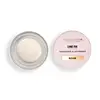What's inside
What's inside
 Key Ingredients
Key Ingredients

 Benefits
Benefits

 Concerns
Concerns

 Ingredients Side-by-side
Ingredients Side-by-side

Dimethicone
EmollientIsododecane
EmollientTalc
AbrasiveDimethicone Silylate
Trihydroxystearin
Skin ConditioningDisteardimonium Hectorite
StabilisingKaolin
AbrasiveHydrogenated Polyisobutene
EmollientPolyethylene
AbrasiveVp/Eicosene Copolymer
Trioctyldodecyl Citrate
EmollientTocopheryl Acetate
AntioxidantLecithin
EmollientBisabolol
MaskingTriethylhexanoin
MaskingSilica
AbrasiveAlumina
AbrasivePropylene Carbonate
SolventEthylene/Methacrylate Copolymer
Sorbitan Sesquioleate
EmulsifyingCaprylyl Glycol
EmollientStearic Acid
CleansingGlycyrrhetinic Acid
Skin ConditioningPEG-40 Stearate
EmulsifyingIsopropyl Titanium Triisostearate
EmollientPentaerythrityl Tetra-Di-T-Butyl Hydroxyhydrocinnamate
AntioxidantMica
Cosmetic ColorantCI 77891
Cosmetic ColorantIron Oxides
CI 77163
Cosmetic ColorantDimethicone, Isododecane, Talc, Dimethicone Silylate, Trihydroxystearin, Disteardimonium Hectorite, Kaolin, Hydrogenated Polyisobutene, Polyethylene, Vp/Eicosene Copolymer, Trioctyldodecyl Citrate, Tocopheryl Acetate, Lecithin, Bisabolol, Triethylhexanoin, Silica, Alumina, Propylene Carbonate, Ethylene/Methacrylate Copolymer, Sorbitan Sesquioleate, Caprylyl Glycol, Stearic Acid, Glycyrrhetinic Acid, PEG-40 Stearate, Isopropyl Titanium Triisostearate, Pentaerythrityl Tetra-Di-T-Butyl Hydroxyhydrocinnamate, Mica, CI 77891, Iron Oxides, CI 77163
Dimethicone
EmollientDimethicone Crosspolymer
Emulsion StabilisingOctyldodecanol
EmollientIsohexadecane
EmollientPhenyl Trimethicone
Skin ConditioningOzokerite
Emulsion StabilisingSilica
AbrasiveMica
Cosmetic ColorantSynthetic Sapphire
Ethylhexyl Palmitate
EmollientCera Microcristallina
Emulsion StabilisingVinyl Dimethicone/Methicone Silsesquioxane Crosspolymer
Helianthus Annuus Seed Oil
EmollientHydrogenated Polyisobutene
EmollientTridecyl Trimellitate
EmollientSorbitan Sesquioleate
EmulsifyingTocopherol
AntioxidantLaminaria Digitata Powder
Skin ConditioningIsocetyl Stearoyl Stearate
EmollientTribehenin
EmollientSorbeth-30 Tetraisostearate
EmulsifyingPalmitoyl Tripeptide-1
Skin ConditioningSodium Hyaluronate
HumectantGlyceryl Behenate
EmollientLimnanthes Alba Seed Oil
Skin ConditioningFullerenes
AntimicrobialSqualane
EmollientCI 77491
Cosmetic ColorantCI 77492
Cosmetic ColorantCI 77891
Cosmetic ColorantDimethicone, Dimethicone Crosspolymer, Octyldodecanol, Isohexadecane, Phenyl Trimethicone, Ozokerite, Silica, Mica, Synthetic Sapphire, Ethylhexyl Palmitate, Cera Microcristallina, Vinyl Dimethicone/Methicone Silsesquioxane Crosspolymer, Helianthus Annuus Seed Oil, Hydrogenated Polyisobutene, Tridecyl Trimellitate, Sorbitan Sesquioleate, Tocopherol, Laminaria Digitata Powder, Isocetyl Stearoyl Stearate, Tribehenin, Sorbeth-30 Tetraisostearate, Palmitoyl Tripeptide-1, Sodium Hyaluronate, Glyceryl Behenate, Limnanthes Alba Seed Oil, Fullerenes, Squalane, CI 77491, CI 77492, CI 77891
 Reviews
Reviews

Alternatives
Ingredients Explained
These ingredients are found in both products.
Ingredients higher up in an ingredient list are typically present in a larger amount.
Ci 77891 is a white pigment from Titanium dioxide. It is naturally found in minerals such as rutile and ilmenite.
It's main function is to add a white color to cosmetics. It can also be mixed with other colors to create different shades.
Ci 77891 is commonly found in sunscreens due to its ability to block UV rays.
Learn more about CI 77891Dimethicone is a type of synthetic silicone created from natural materials such as quartz.
What it does:
Dimethicone comes in different viscosities:
Depending on the viscosity, dimethicone has different properties.
Ingredients lists don't always show which type is used, so we recommend reaching out to the brand if you have questions about the viscosity.
This ingredient is unlikely to cause irritation because it does not get absorbed into skin. However, people with silicone allergies should be careful about using this ingredient.
Note: Dimethicone may contribute to pilling. This is because it is not oil or water soluble, so pilling may occur when layered with products. When mixed with heavy oils in a formula, the outcome is also quite greasy.
Learn more about DimethiconeHydrogenated Polyisobutene is a synthetic polymer. Polymers are compounds with high molecular weight. Hydrogenated Polyisobutene is an emollient and texture enhancer.
In one study, Hydrogenated Polyisobutene showed better skin hydration levels than Caprylic/Capric Triglyceride. As an emollient, it helps keep your skin soft and hydrated by trapping moisture in.
Hydrogenated Polyisobutene is often used as a mineral oil replacement.
Learn more about Hydrogenated PolyisobuteneMica is a naturally occurring mineral used to add shimmer and color in cosmetics. It can also help improve the texture of a product or give it an opaque, white/silver color.
Serecite is the name for very fine but ragged grains of mica.
This ingredient is often coated with metal oxides like titanium dioxide. Trace amounts of heavy metals may be found in mica, but these metals are not harmful in our personal products.
Mica has been used since prehistoric times throughout the world. Ancient Egyptian, Indian, Greek, Roman, Aztec, and Chinese civilizations have used mica.
Learn more about MicaSilica, also known as silicon dioxide, is a naturally occurring mineral. It is used as a fine, spherical, and porous powder in cosmetics.
Though it has exfoliant properties, the function of silica varies depending on the product.
The unique structure of silica enhances the spreadability and adds smoothness, making it a great texture enhancer.
It is also used as an active carrier, emulsifier, and mattifier due to its ability to absorb excess oil.
In some products, tiny microneedles called spicules are made from silica or hydrolyzed sponge. When you rub them in, they lightly polish away dead skin layers and enhance the penetration of active ingredients.
Learn more about SilicaSorbitan Sesquioleate is derived from sorbitol and oleic acid. It is an emulsifier and prevents ingredients from separating.
Specifically, this ingredient is a water-in-oil emulsifier, meaning it helps water dissolve into oil.
Some studies suggest this ingredient may cause irritation in some people. If you are unsure, it is best to patch test.
This ingredient may not be Malassezia folliculitis, or fungal-acne safe.
Learn more about Sorbitan Sesquioleate